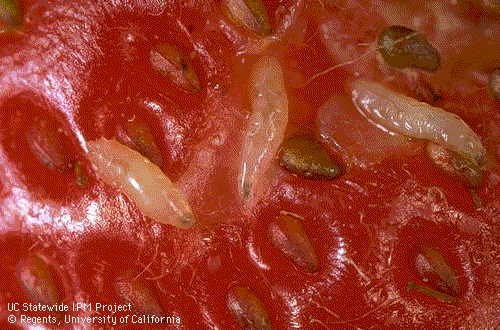Strawberry fruitfly
Drosophila melanogaster
(Diptera: Drosophilidae)

Description:
Fruit flies are small, yellowish flies that are commonly attracted to
fermenting fruit of all kinds. Larvae are about 1/4 inch long and can
be found in very ripe cull and damaged fruit in the fields.
Biology and damage:
Fruitflies are
attracted to very ripe or damaged fruit in the field where they lay
their eggs.
They are primarily a problem in strawberries picked for freezing.
Because this fruit is allowed to ripen in the field in order to allow
easy removal of the
strawberry calyx and core during picking, the harvest interval is
increased and the fruit becomes more susceptible to infestation.
Fruitfly eggs and larvae are primarily a contamination problem.
The life cycle in summer is approximately 7 to 8 days, with adults
laying about 700 to
800 eggs in a 20- to 30-day life span (UC-Davis). Populations
build up as temperatures become warmer. Ideal temperatures for
development of this insect are in the low 80s F (27-30 C). The flies do
not lay eggs at
temperatures below 54 F (12 C) or above 91 F (33 C).
Field scouting/monitoring:
Although no monitoring or treatment guidelines exist for fruit
flies in strawberries, yellow sticky cards can be used to monitor adult
fly populations.
Adults and their offspring may also be monitored using fermented fruit
traps consisting of a container filled with overripe fruit covered with
an
inverted funnel.
Management:
CHEMICAL CONTROL
Chemical insecticides are not commonly used to treat for this pest.
however, it may be possible to treat portions of fields or obvious
sources of flies with pyrethrins to control adults.
California
guidelines
CULTURAL CONTROL:
Limit breeding sites for fruit flies. Make certain that ripe fruit are
completely removed from the plants. When possible, shorten harvest
intervals as
temperatures increase (UC-Davis). Practice good sanitation in and
around the field. Identify and try to clean up external sources of
flies such as cull piles of
strawberries or other rotting fruit and nearby citrus groves where old
fruit may be on the ground.
